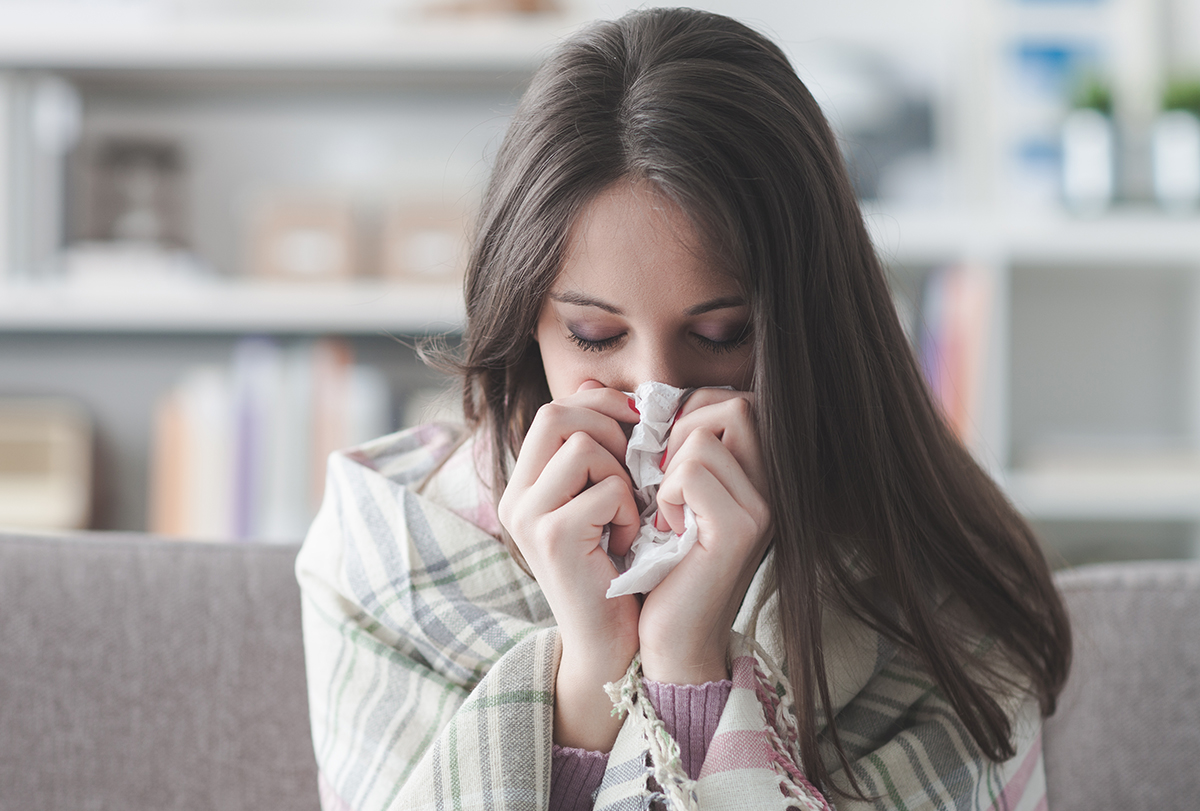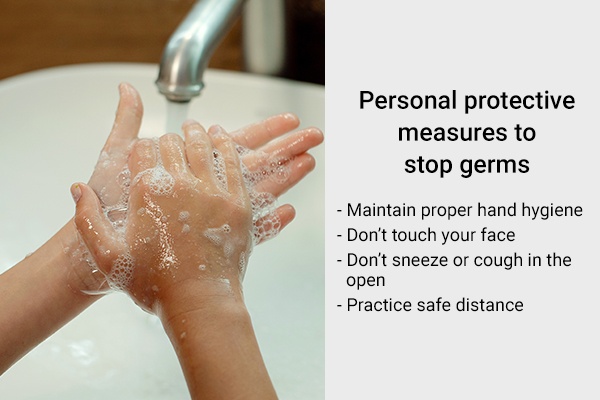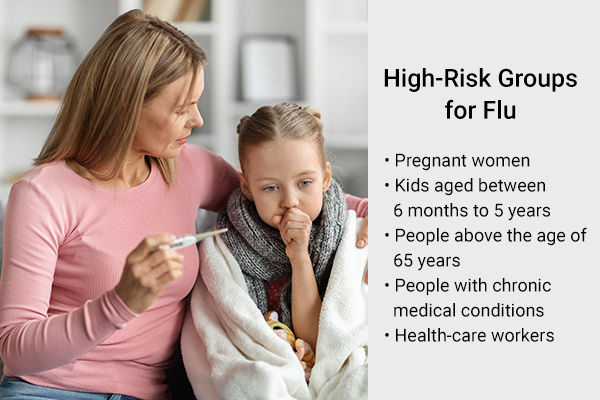In this article:
Influenza (flu) is a seasonal respiratory infection caused by the influenza virus and affects nearly 2%–10% of the global population every year. (1) This highly common and contagious infection primarily targets the nose, throat, and sometimes the lungs.

It can cause mild to severe sickness, but most people recover within a week through proper rest and care at home. In rare cases, the infection can take a turn for the worse and even prove fatal.
About 250,000 to 500,000 people succumb to this infection annually, which is reason enough not to take it too lightly, especially if you have risk factors. (1)
Causes Responsible for Influenza (Flu)
There are four different strains of influenza virus, namely, A, B, C, and D, but only the first two can cause disease in humans. Influenza type A viruses alone are capable of causing pandemics. (2)(3)
The flu season usually lasts from late autumn to early winter but can persist all year round in tropical regions.
Mode of Transmission
Flu mainly spreads through the air. When infected individuals sneeze, cough, or talk, they release respiratory droplets into the air through their nose or mouth. These airborne droplets carry the influenza virus, which can end up infecting others in the vicinity, either directly or indirectly.
Most people contract the virus by breathing in these infected droplets. In other cases, the droplets may land on the surrounding objects or surfaces and contaminate them. Touching the contaminated surface and then using the same hands to touch your nose or face may transmit the virus into your respiratory tract.
The best way to prevent flu is by getting a flu vaccine each year.
What Are the Flu Symptoms?
Flu is characterized by the following symptoms:
- Fever or feeling feverish/chills
- Cough
- Sore throat
- Muscle or body aches
- Headaches
- Fatigue
- Vomiting
- Diarrhea
- Upset stomach
- Pain in the limbs or joints
- Nasal discharge
- Nasal congestion
- Sneezing
- Loss of appetite
Self-Care Tips to Relieve Flu Symptoms

Here are a few self-care measures that may help relieve flu symptoms and promote faster recovery:
- Take plenty of rest to help your body conserve energy, which is needed for fighting the infection.
- Drink lots of water and other nonalcoholic fluids to keep your body properly hydrated.
- Keep yourself warm.
- Consume a nutritious diet replete with fruits and vegetables.
- Stay away from cigarette smoke, which can exacerbate respiratory distress and delay recovery.
- Try steam inhalation to get rid of nasal congestion. Boil some water in a pan, put some vapor rub in it, lean over the steam from a safe distance, and draw deep breaths. The warm vapors will dissolve the mucus buildup inside your nasal cavity so that it can be expelled easily and you can breathe properly. You can also take a warm bath for the same effect. (4)
- Mix half a teaspoon of salt in warm water until it is fully dissolved, and gargle with this solution thrice a day.
- Suck on an ice cube, ice chip, or lozenge.
- Mix some honey and fresh lemon juice in hot water and drink it.
Prevention of Flu
Millions of people come down with the flu every year, but most of them tend to get better without any treatment. All you need to do is rest, eat healthily, stay hydrated, keep warm, and use some easy home remedies to ease your symptomatic discomfort.
If needed, you can take certain OTC medications such as decongestants, NSAIDs, or painkillers to achieve quick relief. But like with every other illness, prevention is better than cure.
The influenza virus comes into circulation every year and triggers widespread illness. Adopting the following preventive measures during the flu season can help reduce your risk of contracting the infection or spreading it to others.
1. Get vaccinated
The best way to avoid the flu or a serious case of the flu is to get vaccinated against it. (5) Influenza virus type A spreads rather easily and has triggered multiple pandemics over the years.
It takes approximately 14 days after vaccination for a healthy adult to reach peak antibody protection. (6)
The flu vaccine has been administered for more than 60 years as part of public health management to safely and effectively curb this disease. You need to get the shot every year before the advent of the flu season.
This simple step can greatly reduce your risk of getting the infection. Moreover, vaccinated people who do get the flu tend to develop very mild symptoms. (4)
2. Implement personal protective measures (hygiene etiquette)

- Maintain proper hand hygiene: Your hands pick up a lot of germs from contaminated surfaces on a daily basis. Touching your eyes, nose, or mouth with unclean hands can transfer the germs inside your body and trigger an infection. The same holds true for the influenza virus. Thus, you are recommended to wash your hands frequently with soap and warm water during the flu season. This simple measure will help reduce your risk of catching the infection. (7)(8)
- Don’t touch your face: Keep your hands away from your nose, mouth, and face as much as possible to prevent the virus from entering your system. If you must touch your face, make sure to wash your hands thoroughly with soap and warm water for at least 30 seconds beforehand. (6)
- Don’t sneeze or cough in the open: Cover your mouth and nose with a tissue when you feel a cough or sneeze come on. This will stop the respiratory droplets from releasing into the environment and infecting others or contaminating surfaces. Quickly dispose of the used tissue in the trash bin thereafter. If a tissue is not readily available, cough or sneeze into your elbow to contain the spread of the virus.
- Observe a safe distance: If you get even an inkling of fever or other signs of infection during the flu season, immediately isolate yourself from others to limit the spread of the infection. Conversely, avoid close contact with people who have the flu or show any sign of sickness to protect yourself from the virus.
3. Use a humidifier
Lack of moisture in your living environment can further dry out and harden the mucus clogging your nose, making breathing more difficult. Installing a humidifier in your home can significantly reduce the respiratory distress caused by the flu.
A humidifier imparts moisture to the air, which will help liquefy the mucus consolidated inside your nasal passages so that it drains out swiftly. (9)
4. Maintain proper nutrition
You are recommended to consume a healthy, well-balanced diet that contains lots of fruits and vegetables rich in antioxidants and vitamins. These nutrients will improve your immunity and overall health while lowering your risk of contracting the flu. (10)
Here are some additional dietary recommendations that can prove useful in avoiding or fighting the influenza virus:

a. Increase your intake of vitamin C
Vitamin C is a powerful antioxidant that is extremely beneficial for your respiratory health. It strengthens your immune system to defeat viral infections such as the flu quite easily.
One case study even recommends intravenous administration of vitamin C as a vital treatment against acute viral infections. (11)(12)
Thus, you are recommended to add foods high in this vitamin to your regular diet to improve your immunity during the flu season.
b. Increase your intake of garlic
Garlic is credited with considerable antiviral activity that may prove effective against influenza. (13) Thus, you should add more of it to your regular diet, especially when flu is in the air.
c. Drink green tea
Gargling with herbal tea or drinking it regularly during the flu season can help bolster your immunity to keep the infection at bay. And if you do come down with the flu, this medicinal tonic can help reduce your symptoms and speed up recovery.
Green tea is particularly loaded with antioxidants such as catechins that are known to inhibit the proliferation of cold and flu viruses inside the body. (14)(15)
Green tea can be consumed just normally, without using added sugar. If you still need to sweeten the tea, the best choice is honey as it is also a remedy for colds.
What Is the Treatment for Flu?
Most cases of flu resolve on their own without any treatment in a matter of 7–10 days, but you can use certain OTC medications to manage its symptoms at home. These include:
- Painkillers such as acetaminophen and nonsteroidal anti-inflammatory drugs (NSAIDs) such as aspirin and naproxen to reduce body aches and fever
- Decongestants to relieve nasal congestion
Doctors also prescribe antiviral drugs such as oseltamivir (Tamiflu®), zanamivir (Relenza®), and peramivir (Rapivab®), which control the spread of influenza virus in the body to avoid severe illness and complications such as bacterial pneumonia.
These medications are most effective when taken within 48 hours of the onset of flu symptoms. Thus, it is important to seek prompt medical attention for timely diagnosis and treatment. (16)
How Is Flu Diagnosed?
A blood test will be performed and then the doctor will collect a swab sample from your throat or nose and send it for lab testing. The commonly used tests for this purpose are:
- Direct antigen detection
- Reverse transcriptase-polymerase chain reaction (RT-PCR) (5)
Who Are at a Higher Risk of the Flu?

Flu is generally not a cause for concern, but it can affect certain people more seriously than others. Some high-risk groups that are especially advised to maintain their annual flu vaccination are:
- Pregnant women
- Kids aged between 6 months and 5 years
- People above the age of 65 years
- People with chronic medical conditions
- Healthcare workers (17)
Most-Asked Questions About Influenza (Flu)
Who are at higher risk for flu?
The following groups are more susceptible to contracting the flu and developing complications due to the infection:
- Children below the age of 4 years
- Adults above the age of 65 years
- People with chronic medical disorders (such as cardiopulmonary disease, diabetes mellitus, renal or hepatic insufficiency, hemoglobinopathies, and immunodeficiency)
- Women in the second or third trimester of pregnancy
- Patients with disorders that impair the handling of respiratory secretions (such as cognitive dysfunction, neuromuscular disorders, stroke, and seizure disorders)
- Patients below the age of 18 years who regularly take aspirin – They are at risk of Reye’s syndrome, which can cause swelling in the liver and brain. (18)
What are the differences between flu and COVID-19?
Flu and COVID-19 are both respiratory infections that are highly contagious and have many similar symptoms such as fever, nasal discharge, cough, headaches, fatigue, and sore throat. But here are some key differences between the two:
- Flu is caused by the influenza virus, whereas COVID-19 is caused by a coronavirus named SARS-CoV-2.
- Patients with COVID-19 develop symptoms 2–14 days after exposure to the coronavirus, whereas flu symptoms tend to appear within 1–4 days after exposure to the influenza virus.
- COVID-19 symptoms persist far longer than flu.
- COVID-19 tends to remain contagious far longer than flu.
- Unlike flu, COVID-19 can trigger serious long-lasting complications such as blood clots, systemic inflammation, and brain fog.
Flu and COVID-19 share many common symptoms, which means they cannot be distinguished on the basis of symptoms alone. Thus, you have no choice but to get tested for a proper diagnosis.
Certain PCR tests can test for flu and COVID-19 at the same time, but you will require separate testing if these are not available. Talk to a healthcare provider about getting tested for both flu and COVID-19 if you have symptoms. (19)
Can I have flu and COVID-19 at the same time?
Yes. It is possible to contract flu and COVID-19 simultaneously, but there isn’t enough data to know how commonly this happens. Studies are being conducted to determine the same. (19)
Final Word
The first thing you need to do to avoid infections such as the flu is to build your immunity through a healthy diet and lifestyle. During weather changes, pay additional attention to hygienic precautions.
Another simple method for battling germs that cause the flu is by being vaccinated. If your symptoms increase or don’t improve after 7–8 days, don’t ignore them – talk to a professional and get assistance.
- Was this article helpful?
- YES, THANKS!NOT REALLY


